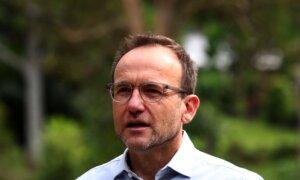‘You could probably use the independent vote to measure the implied competence of the “uniparty,”’ political analyst Graham Young said.
It’s not just Labor that’s staging a return in the 2025 federal election.
The “Teals” and independents, who first shook the system in 2022, are once again emerging as a powerful force, defying the traditional two-party dominance.
While several seats remain undecided, early counts suggest strong performances by high-profile independents and Climate 200-backed Teals across key electorates.
In some cases, they’ve defeated major party incumbents with safe margins, while in others, they are mounting significant challenges.
Independents Flip Safe Seats With Commanding Margins
In New South Wales (NSW), Independent Andrew Gee, who left the Nationals in 2022, defeated Nationals candidate Sam Farraway in Calare.
Gee secured 56.3 percent over Farraway’s 43.7 percent, a swing of over 15 percent in a seat previously considered safe for the Nationals.
In Wentworth, high-profile teal MP Allegra Spender has comfortably retained her seat against Liberal candidate Ro Knox. Spender achieved 56.7 percent, ahead of Knox’s 43.3 percent, securing a second term in this once-blue-ribbon seat.
Victoria’s Indi has remained firmly in independent hands, with Helen Haines defeating Liberal challenger James Trenery.
Haines captured 58.4 percent against Trenery’s 41.6 percent, delivering a strong third-term victory.
A Reckoning for the Two-Party System
Backed by over $10 million from Simon Holmes à Court’s Climate 200, Teal candidates—mostly professional women with local community roots—have proven their staying power.
Climate 200 backs independents who campaign on climate policy and gender equity.
Graham Young, pollster and political analyst at the Australian Institute for Progress, says the trend is driven by eroding confidence in the two-party system.
“In fact, you could probably use the independent vote to measure the implied competence of the ‘uniparty,’” Young told The Epoch Times.
He noted that about one-third of voters opted for a candidate outside the Coalition or Labor this election.
“In the early 70s, fewer than 10 percent voted for minor parties and independents,” he said.
Though preferences often bring votes back to major parties, Young sees the initial support for independents as a clear protest against policy and representation failures.
Traditionally, independents were hyper-localised, like Ted Mack in North Sydney or Cathy McGowan in Indi.
But the new wave, backed by strategic funding and professional campaigning, is more systematic in its targeting of affluent Liberal-held seats.
“They target mostly upper-middle-class seats held by the Liberal Party that have a low Labor vote, but where a significant minority of Liberal voters are not aligned with the party on mostly three issues—climate change, women in politics and corruption,” Young said.
He likens the model to a political franchise rather than true independence.
“If they can peel off enough Liberals, and marry them to tactically voting Labor and Greens voters, they have the potential to win these seats on preferences.”
Count Continues in Key Contests
While some contests are settled, others remain in limbo as preference distributions continue.
The independent surge has added volatility in seats long viewed as party strongholds, unseating candidates or narrowing the vote to razor-thin margins.
In Labor-held Bean in the ACT, Teal independent Jessie Price is pushing sitting Labor MP David Smith to the brink.
As of May 7 noon, Smith leads by just 748 votes in a seat that Labor won with a 25.9 percent margin in 2022.
In Bradfield, NSW, the count remains tight between Liberal candidate Gisele Kapterian and Teal independent Nicolette Boele.
Kapterian holds a razor-thin lead with 50.1 percent while Boele trails closely at 49.9 percent—a mere 195-vote difference.
Goldstein is also on a knife-edge. Former Liberal MP Tim Wilson has nudged ahead with 50.3 percent against incumbent Zoe Daniel’s 49.7 percent, a dramatic shift from Daniel’s previous win.
In Flinders, Victoria, the vote has turned into a three-candidate-preferred contest, with a tight battle for second place between independent Ben Smith and Labor’s Sarah Race. Both are at 22 percent, with just 277 votes separating the two.
While Liberal MP Zoe McKenzie is ahead in first preferences at 41.16 percent, preference flows depending on who takes second spot could shift the entire result.
Kooyong, Victoria, another high-profile teal seat, remains tight. Independent Monique Ryan, who famously ousted Treasurer Josh Frydenberg in 2022, is narrowly ahead of Liberal candidate Amelia Hamer.
Ryan has 50.3 percent with Hamer just behind at 49.6 percent—a lead of just 622 votes.
In the Victorian seat of Monash, two independent candidates have significantly disrupted the traditional two-party contest. Liberal candidate Mary Aldred is currently leading with 32.4 percent, while Labor’s Tully Fletcher trails behind at 20.3 percent.
Independents Deb Leonard and sitting MP Russell Broadbent, who quit the Liberals in 2023, have secured 17.3 percent and 10.3 percent, respectively.
The contest remains open as preferences continue to be distributed.
Big Names Face Indie Fire
This election also saw independents take on political heavyweights. They may not have won, but they certainly made their presence felt.
In Watson, NSW, independent Ziad Basyouny secured 30.7 percent against Home Affairs Minister Tony Burke, who won with 69.3 percent.
Both candidates are of Egyptian origin and contested in an electorate with a significant Muslim population, where Labor’s position on Gaza was expected to influence results. Basyouny, backed by Muslim Vote Matters, exceeded expectations despite the loss.
In Wannon, Victoria, Shadow Minister Dan Tehan narrowly retained his seat against independent Alex Dyson, who polled 46.2 percent (44,735 votes).
Tehan’s lead of just 7,362 votes is significantly down from previous margins, reflecting rising independent momentum even in regional strongholds.
Agriculture Minister Julie Collins also faced an unexpectedly strong challenge from anti-salmon farming campaigner and independent Peter George in Franklin, Tasmania.
Collins retained the seat with 57.3 percent against George’s 42.7 percent.







